- The danger of the Aroids family
- Danger of bulbous plants
- Euphorbia - harmful family
- Cucumbers - dangerous handsome
- Nightshade - bright and dangerous
- Coniferous and Aral-like
- Indoor plants harmful to cats
- Conclusion
Flowers fill our homes with beauty and comfort, saturateair oxygen and absorb harmful substances, but there are harmful indoor plants that can be dangerous to human health and animals. The juices of many of them irritate the mucous, cause swelling, vomiting and damage the skin. Especially this applies to cats who like to eat fresh herbs if they are always at home. Owners of pets know perfectly that their green windowsill can suffer from pets, but animals can suffer themselves if they swallow a stem or leaf of a poisonous flower. Which plants are the most harmful?
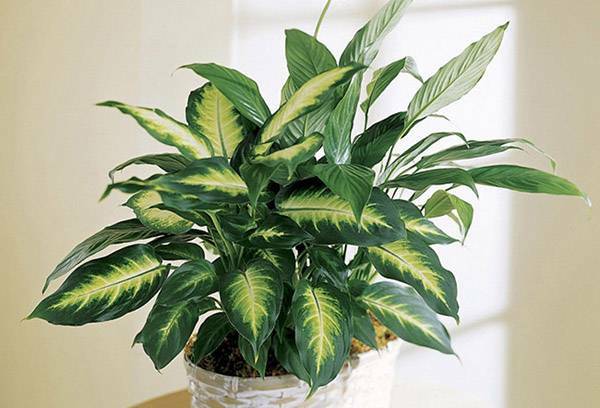
Dieffenbachia
The Danger of the Family of Aroids
The juice of many representatives of the Aroids is toxic. It contains green parts of the plant. If swallowed, swelling of the oral cavity occurs, in case of contact with the eyes - corneal diseases and conjunctivitis.
This family includes such popular indoor flowers:
- Aglaonema;
- alocasia;
- anthurium;
- diffenbachia;
- zamiokulkas( dollar tree);
- zandedeskiya( calla);
- monster;
- syngonium;
- spathiphyllum( female happiness).
For cats, the danger is a monster - if they swallow a piece of leaf, a burning sensation appears in the mouth, blisters. The juice of the vine contains a poison that causes diarrhea. When poisoning diffenbachia, there is a risk of suffocation. Plants that are harmful to human health are often valued for useful properties and kept at home as medicinal. For example, alocasia juice is used in folk medicine: it is believed that its tincture is effective against cancer.
Tip
For any symptoms of poisoning in animals or humans, it is necessary to give the affected person activated charcoal and call a doctor.
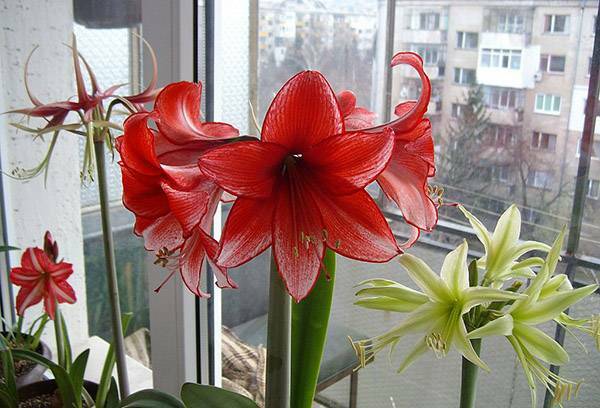
Amaryllis
Danger of bulbous plants
Almost all bulbous, in particular the Amaryllis family, are poisonous. The family of Amaryllis can harm birds and other domestic pets, especially you need to be attentive to cat lovers. This applies to eucharis, hippeastrum, Cleivia, hemanthus, birdworm and garden representatives of the family. In the green parts and scales of bulbs contain cavities with mucus, which flows if they are damaged. Cleavia can cause paralysis.
The poultrywoman has a very burning juice, which, nevertheless, is also used for medicinal purposes. Some people grow their homes specially to prepare tinctures from pain in the spine.
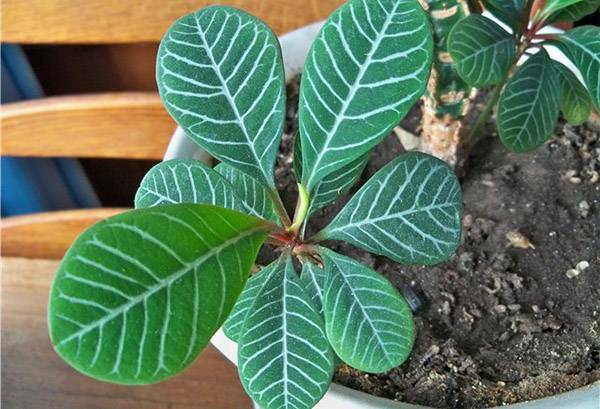
Euphorbia
Euphorbia - harmful family
No less dangerous family of Euphorbia. Children, birds and animals, especially cats, should not be allowed to contact them. Euphorbia belovolkovy is very similar to a palm externally - it often lives at home with amateur growers, as it is a shade-tolerant plant, does not require special care and multiplies easily. Populary and spleen Mil, some varieties of which are very decorative flowers.
Croton - an attractive plant with colorful leaves of unusual shape - also refers to the spurge. Other representatives of the family, common in indoor floriculture, are jatropha, acalifa. Their resin and juices contain poisons that cause severe poisoning, which are accompanied by the appearance of vomiting and disorders of nervous regulation. When they come into contact with them on mucous membranes, non-healing ulcers, burns and inflammations appear.

Adenium fat
Cuddly - dangerous handsome
Poisonous milky juice is found in attractive plants of the Kutrovye family. It can greatly damage both the domestic pet and the person. Substances contained in allamanda, catarrhatus, pachypodium and rauvolphia, can lead to death. One of the representatives - adenium fat, is gaining popularity among florists due to the unusual thickened form of the stem - caudex. These houseplants are considered a home decoration. Their flowers are very beautiful: over the past few years, breeders have brought an unthinkable number of varieties with a variety of colors, non-double and double petals.
Mandeville, or diplazheniya, is the dream of many amateur growers, which can become the highlight of any collection. But its juice contains substances that, when ingested, cause disorders from the nervous and cardiovascular system. For small animals, such as cats, this is a sure death. Oleanders are very attractive and dangerous plants that are often kept at home. They are called the "flower of suicides": it is enough to get one leaf into the body to cause irreversible consequences.
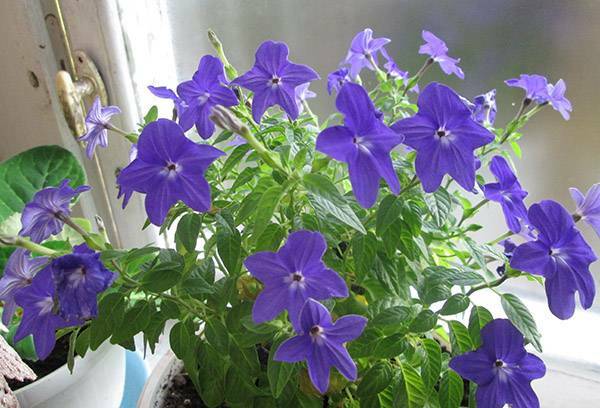
Brillia
Nightshade - bright and dangerous
Nightshade, whose berries look very attractive for birds( and children), contain alkaloids that cause nausea, drowsiness and vomiting. This is nightshade, indoor decorative peppers, brugmansia, brolly, - they are often at home with florists. Datura also refers to this family. The ancient Romans used the harmful berries of Solanaceae to prepare poisonous substances for their enemies. Frequent guests of summer beds - petunia, fragrant tobacco - are no less dangerous, all parts of these flowers are poisonous.
Potato belongs to Solanaceae. He binds poisonous berries, which formerly were poisoned by people who did not know that eating must be a root crop. Useful plants, often present at many people's homes on the dining table: tomatoes, eggplant, pepper - also belong to this family. In fruit juices contain solanine - an alkaloid, which can cause insomnia, dizziness, diarrhea and diseases of the cardiovascular and nervous system. The result of contact with poisonous parts of the plant can be numbness of the muscles, dysfunction of the thyroid gland, chronic pain in the joints, a violation of the absorption of calcium.

Pelargonium
Coniferous and Aral-like
Coniferous houseplants are rare guests at home, except in the form of bonsai. But it's worth remembering that they can be dangerous. Some representatives contain poisons that irritate the mucosa and the gastrointestinal tract, depress the cardiac muscle, and can cause breathing to stop. For example, yew was known for similar properties in ancient times: with its help it was possible to poison enemies if you give them wine in a cup of this tree.
Fruits and seeds of the plant family Aralievy contain toxic substances that cause disorders of the nervous system. His house representatives often meet at home and cause curiosity in cats:
- Japanese aukuba,
- begonia,
- pelargonium,
- polisias,
- fatsia,
- fatshedera,
- scheffler.
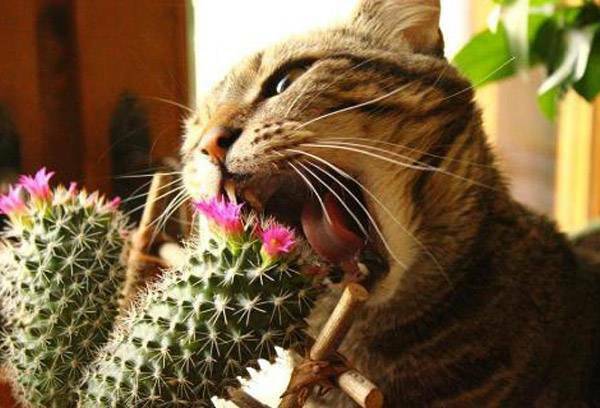
Indoor plants harmful to cats
For cats that live at home, there is a problem: how to find yourself green, a source of vitamins and a means of cleansing the intestine. Because they often gnaw on indoor plants, not paying attention to whether they are harmful or useful. Some owners believe that pets should figure out what flowers they can eat, but this is misleading. These animals are very fond of the hard dracaena leaves, which can scratch the sky and cause a laryngeal edema. Often they gnaw ficuses containing poisonous milky juice. The most dangerous for cats - adeniums, oleanders, diffenbachia and monsters, the ingestion of leaves can lead to death.
Indoor plants, if there is an animal at home or a child who does not understand what pulls into the mouth, one must choose especially carefully. Cactus is very dangerous for animals, which for some reason often attract cats. The spines get stuck in the sky and they can not be removed without causing additional injuries to the animal.
advice If this still happens, you must put a piece of butter in your mouth and be sure to be taken to the veterinarian.
Even a very beautiful and, at first sight, harmless flower, such as pelargonium, can cause a strong allergic reaction. The medicinal plant of aloe, which is practically in every house, can have irritating effect on the skin and intestines.
Advice
Harmful houseplants are not as dangerous if they are inaccessible. Therefore, if there are animals in the house, especially cats, and it is impossible to get rid of the flower, it is better to take them away so that the animal can not reach. You can hang them to the ceiling in a special pot.
Conclusion
Many attractive indoor plants that are attractive and popular among florists can be dangerous for humans and animals. Especially for cats, because they like to eat fresh greens. This group includes almost all bulbous, representatives of the Aroids, the family Kutrovye and Nightshade.
When ingested, some of these plants( oleander, adenium) can not only harm the health, but also lead to death. If a person or animal has symptoms of poisoning, he should give activated charcoal and immediately call a doctor. Dangerous plants need to be removed to places where it is impossible to reach them.



